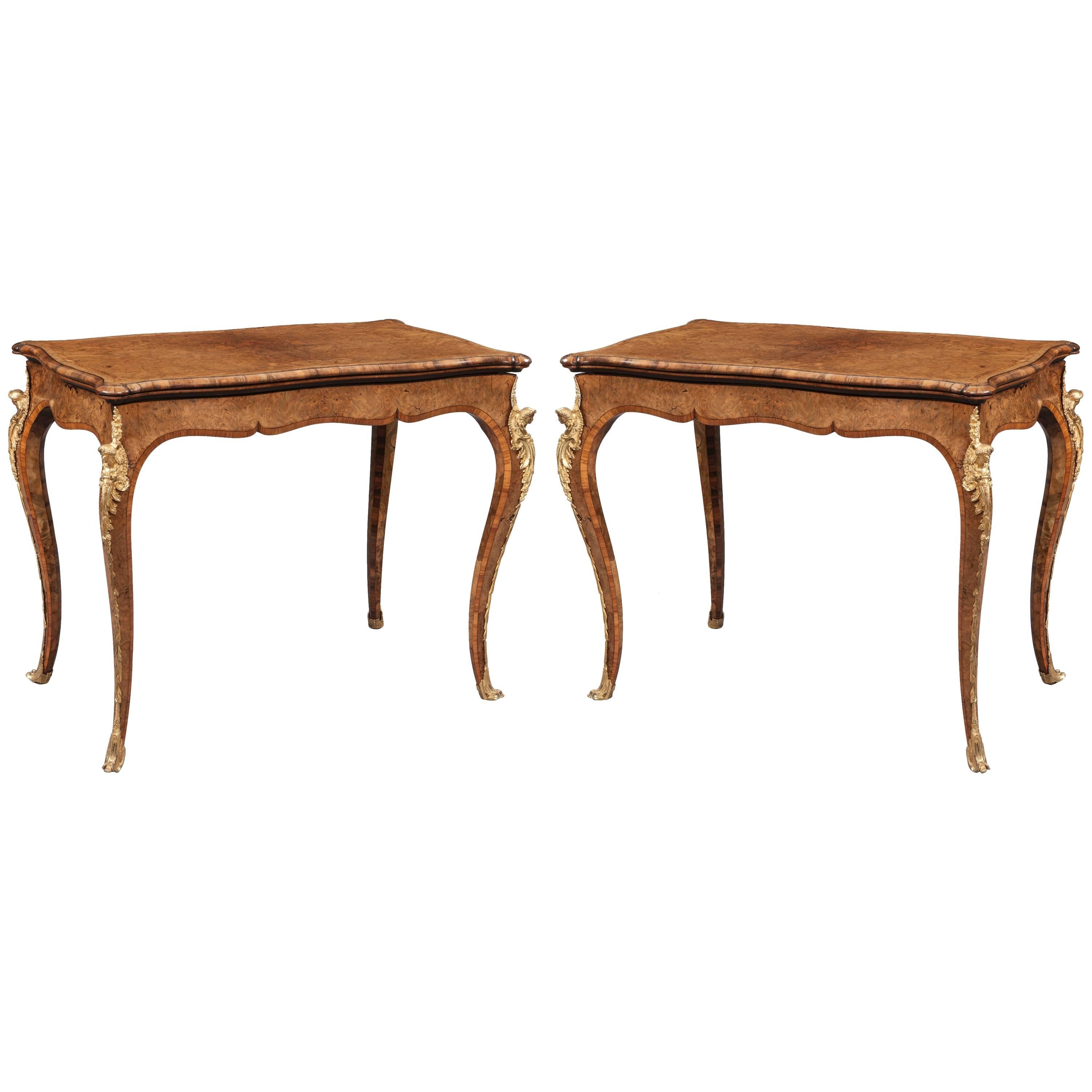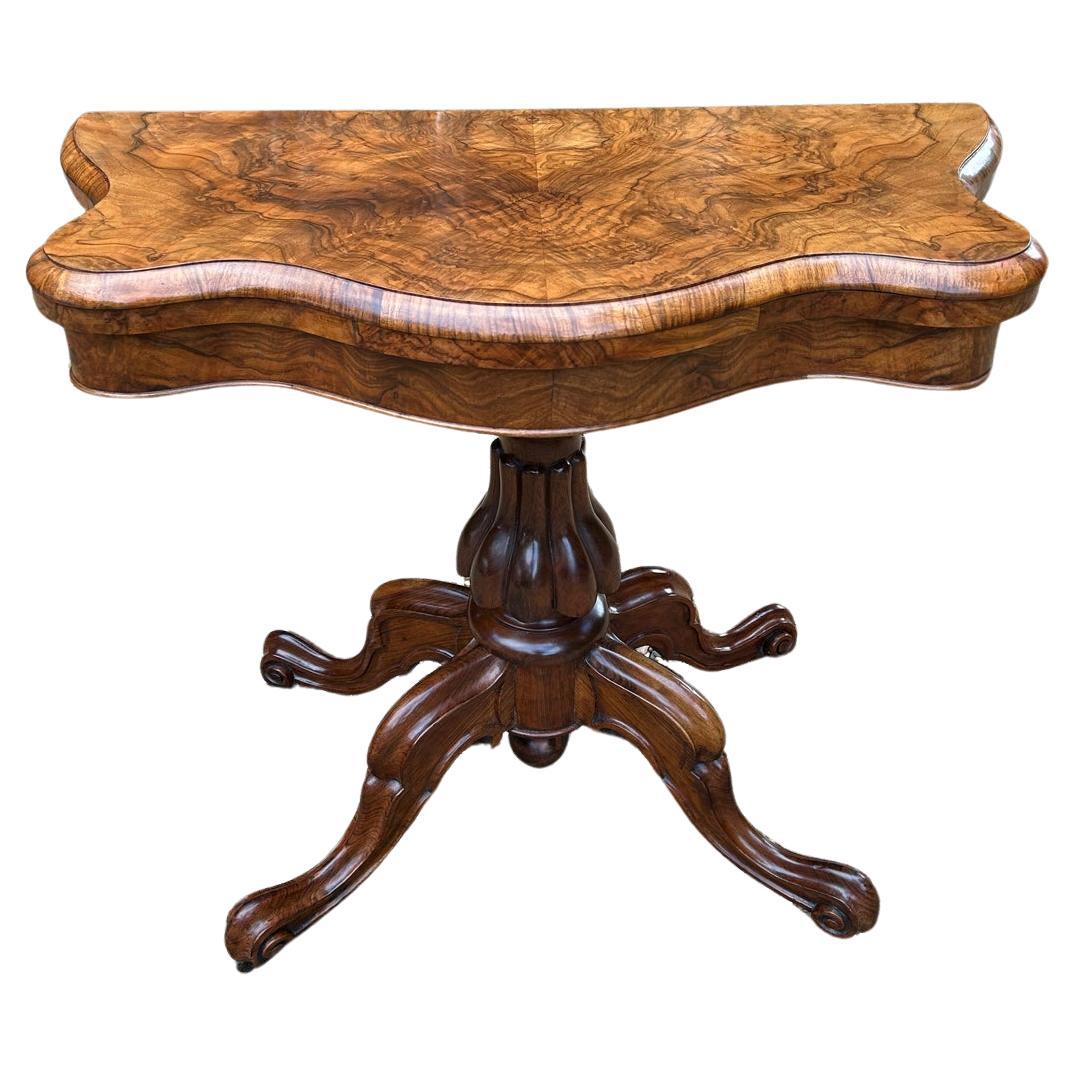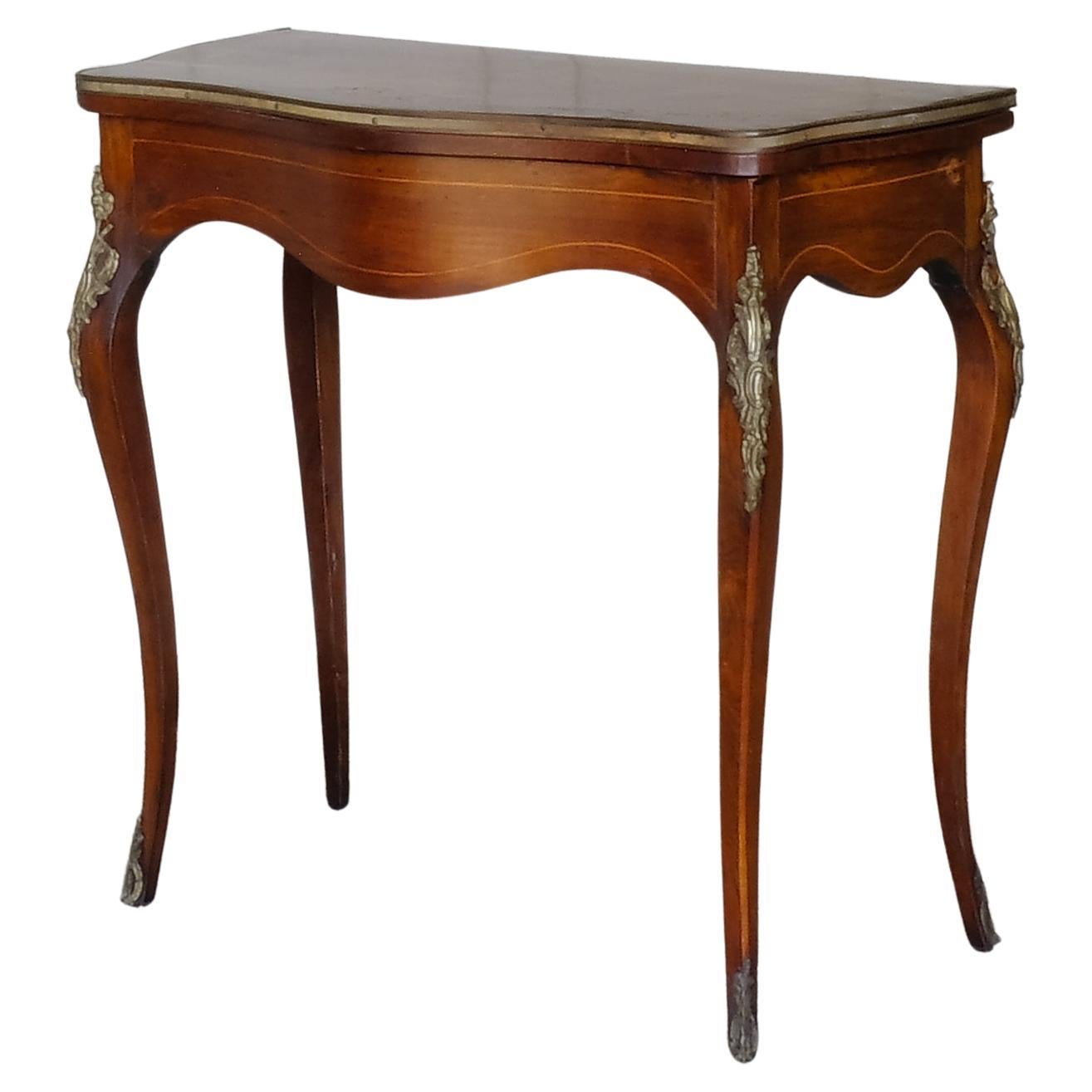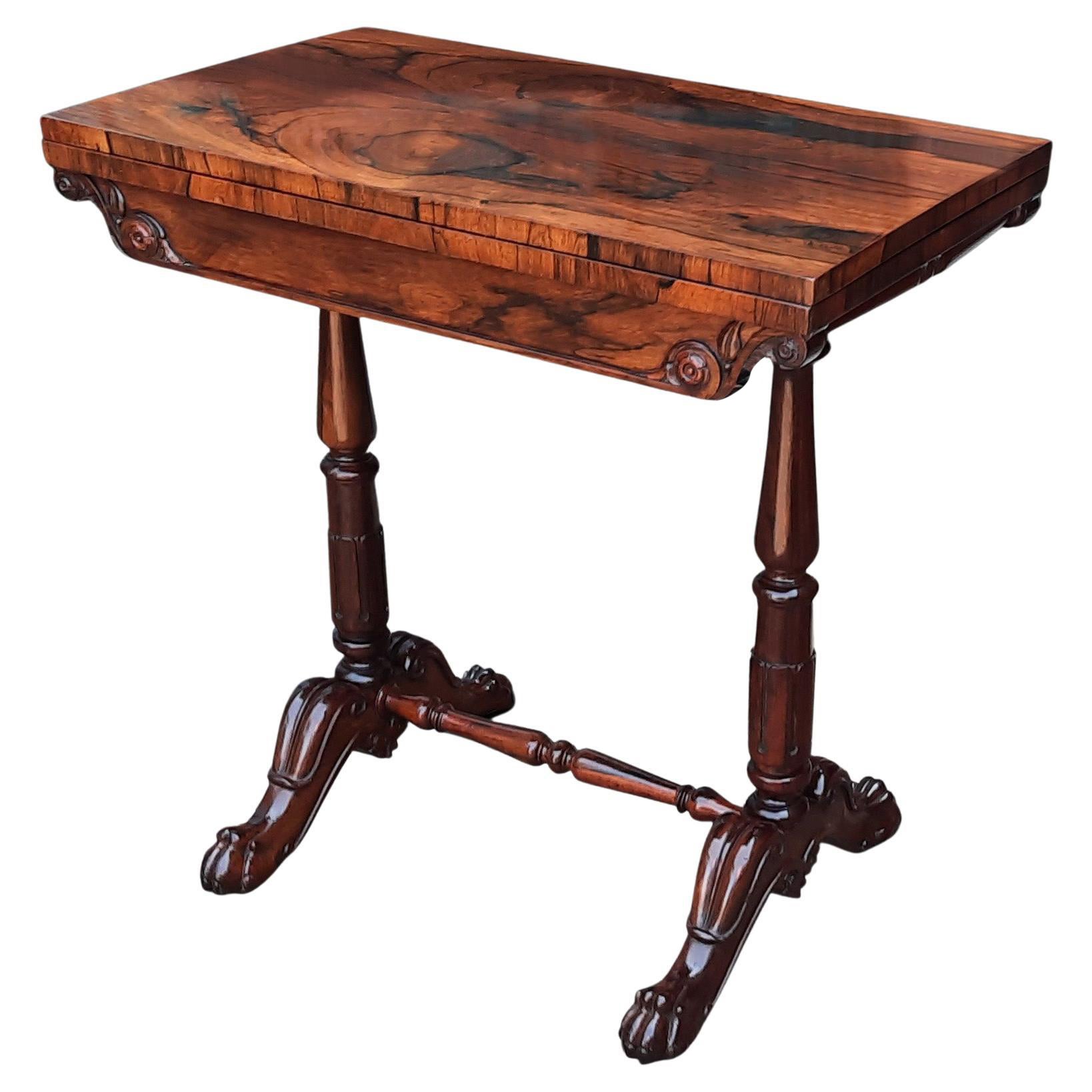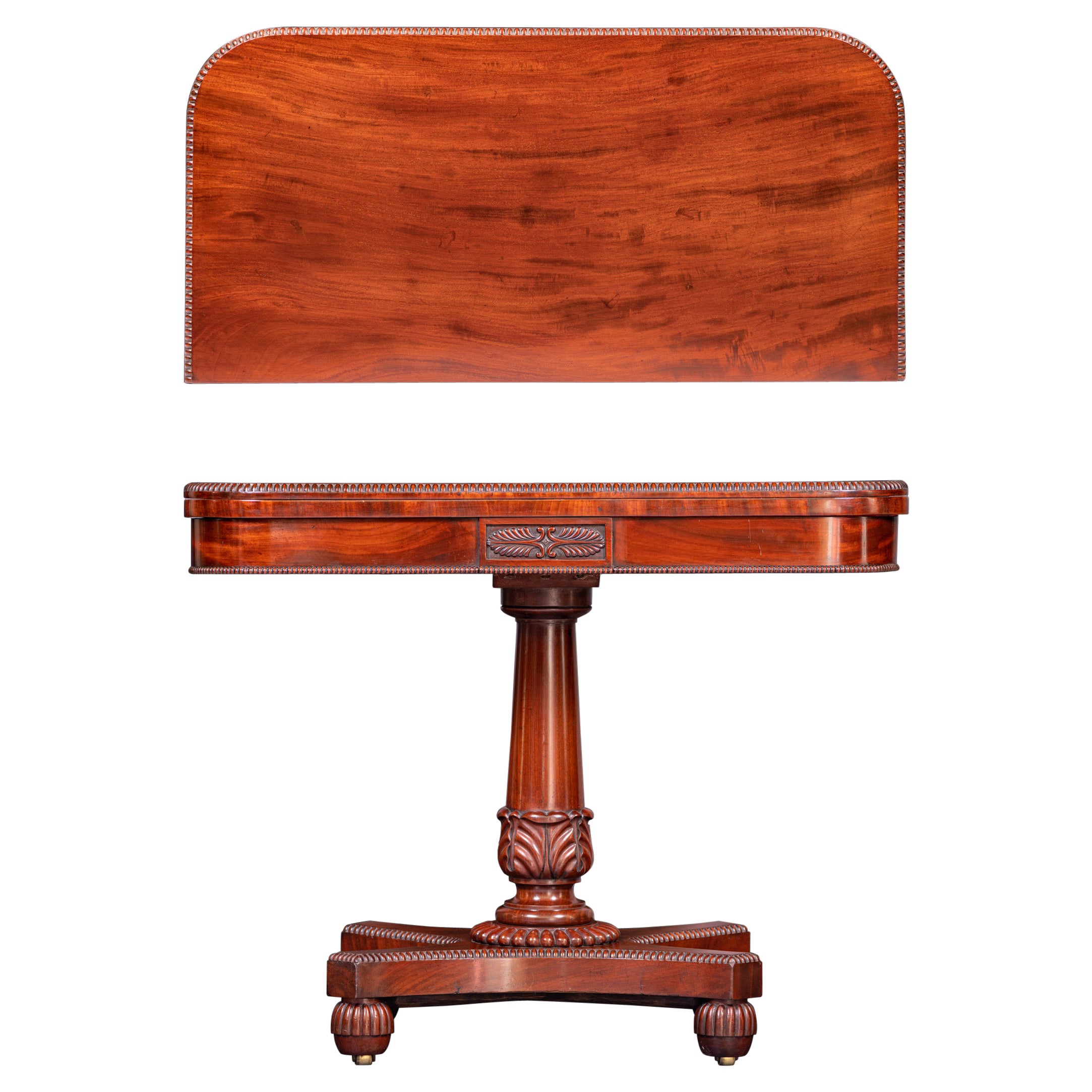Items Similar to 19th Century Walnut Serpentine Card Table Firmly Attributed to Gillows
Want more images or videos?
Request additional images or videos from the seller
1 of 14
19th Century Walnut Serpentine Card Table Firmly Attributed to Gillows
About the Item
A walnut serpentine card table firmly attributed to Gillows
Constructed using finely figured Circassian walnut, dressed with gilt bronze mounts; rising from slender kingwood banded cabriole legs shod with bronze sabots and espagnolettes. The shaped serpentine folding swivel top opens to reveal a green baize playing surface.
- Attributed to:Gillows of Lancaster & London (Cabinetmaker)
- Dimensions:Height: 23.04 in (58.5 cm)Width: 39.38 in (100 cm)Depth: 29.14 in (74 cm)
- Style:Louis XV (In the Style Of)
- Materials and Techniques:
- Place of Origin:
- Period:
- Date of Manufacture:circa 1855
- Condition:Wear consistent with age and use.
- Seller Location:London, GB
- Reference Number:
About the Seller
5.0
Recognized Seller
These prestigious sellers are industry leaders and represent the highest echelon for item quality and design.
Platinum Seller
These expertly vetted sellers are 1stDibs' most experienced sellers and are rated highest by our customers.
Established in 1964
1stDibs seller since 2012
42 sales on 1stDibs
Typical response time: 3 hours
Associations
The British Antique Dealers' AssociationLAPADA - The Association of Arts & Antiques Dealers
- ShippingRetrieving quote...Ships From: London, United Kingdom
- Return PolicyA return for this item may be initiated within 3 days of delivery.
More From This SellerView All
- Pair of English Burr Walnut Card Tables Attributed to Gillows of LancasterBy Gillows of Lancaster & LondonLocated in London, GBA near pair of card tables firmly attributed to Gillows of Lancaster. Designed in the Louis XV manner, and constructed using a finely grained Circassian burr walnut, with kingwood crossbanding and boxwood stringing, with gilt bronze adornments; rising from swept cabriole legs, dressed with foliate gilt bronze sabots, and female espagnolettes, the hinged and rotating serpentine tops, reveal playing surfaces of inset red baize within gilt tooled morocco...Category
Antique 19th Century English Louis XV Card Tables and Tea Tables
MaterialsOrmolu
- George IV Period Games Table Attributed to Gillows of LancasterBy Gillows of Lancaster & LondonLocated in London, GBConstructed in a finely figured goncalo alves; the end supports having square uprights, each enclosing three tapering and turned ‘triple spindles’, with ‘running pearl’ adornments, a...Category
Antique 19th Century English George IV Game Tables
MaterialsWood
- 19th Century Shaped Centre Table with Inlay and Gilt Metal by GillowsBy Gillows of Lancaster & LondonLocated in London, GBAn Antique Shaped Centre Table by Gillows Constructed in Circassian walnut, with specimen woods inlays, and gilt metal adornments; rising from a castor sho...Category
Antique 19th Century British Victorian Center Tables
MaterialsMetal
- French Card Table with Parquetry and Gilt Bronze Mounts, 19th CenturyLocated in London, GBA fine card table in the Louis XVI manner. Constructed in kingwood with purpleheart crossbanding, and dressed with superbly cast and chased mercury gilt bronze mounts; rising from...Category
Antique 19th Century French Louis XVI Card Tables and Tea Tables
MaterialsBronze
- 19th Century Coromandel and Inlaid Table Attributed to Jackson & GrahamBy Jackson & GrahamLocated in London, GBA magnificent library table Attributed to Jackson & Graham Of free standing rectangular form, constructed in coromandel, with inlays in thuya, ebony, boxwood, and honeysuckle; the fluted legs rising from square brass castor-shod feet; the frieze housing two lockable drawers fitted with rare ‘tamper proof’ Chubb locks and having quadrant moulded cedar lined interiors; the platform having a central panel of beautifully chosen matched coromandel veneers, with an outer guard border of a running pattern of stylised anthemions; the ebony edges having a thumb nail moulding, circa 1865 The firm of Jackson & Graham established in 1836 by Thomas Jackson and Peter Graham at 37 Oxford Street London, and for the next fifty years produced predominately high quality furniture and represented Britain at many of the international exhibitions. Their clients included Queen Victoria, Napoleon III, the Grand Khedive of Cairo and the royal palace in Siam. They were particularly noted for their fine marquetry work, the use of Wedgwood plaques, rare woods, and fine casting of bronze mounts. They engaged the leading designers of the period, inter alia, Owen Jones, Bruce Talbert, Alfred Lorimer and Eugene Prignot. In the mid-1850s the workforce was recorded as 250, and by 1875, the company was employing 600 workers. They were feted exhibitors at many of the Great Exhibitions of the 19th century, and frequent prize winners. At the Paris International Exhibition of 1878, the furniture jury noted of them ‘ the workmanship is so perfect that even with the aid of a magnifying glass scarcely the slightest imperfection is to be found’. In 1885 the company was absorbed by Collinson and Lock, who continued their standard of excellence. Charles Chubb was apprenticed as a blacksmith before starting business as a ships’ ironmonger in Winchester. Jeremiah soon joined the business, and by 1818 the brothers had branched out into lockmaking, founding the famous Chubb Company. The business really got started when Jeremiah Chubb patented his new ‘detector lock’ in 1818. The lock was constructed so that if someone tried to pick it or open it with the wrong key it became inoperable. To make the lock work again the owner had to use a special key supplied with the lock. The aim of the detector lock was to prevent burglaries, and to warn the owner that someone had tried to break into their property. The lock soon became popular, and sales of the Chubbs’ products increased even more when they won a government competition to design a lock that could only be opened using its own key. After the invention of the detector lock, the Chubbs decided to move to Wolverhampton, which already had an established lock making industry. By 1838 they were making 28,000 locks a year at their Wolverhampton factory. Another product was added to the Chubb range in 1835 when a patent was taken out for a burglar resistant safe, and in 1837 the Chubb safe...Category
Antique 19th Century English Tables
MaterialsBrass
- Pair of 19th Century English Regency Gonçalo Alves Card Tables with Brass InlayLocated in London, GBA pair of Regency card tables Constructed in Gonçalo Alves, and dressed with extensive brass marquetry work; rising from quadripartite swept legs terminating in brass anthemion decorated toes with inset brass castors, conjoining incurved rectangular plinths having gadrooned moldings; the tapering swept rectangular columns support the swiveling hinged radiused corner tops, opening to reveal green baize playing surfaces, with raised tablets to the fascias. The prolific usage of brass marquetry work in England was employed by various distinguished cabinet makers including Thomas Parker...Category
Antique Early 19th Century English Regency Card Tables and Tea Tables
MaterialsBronze
You May Also Like
- 19th Century Burr Walnut Serpentine Card TableLocated in Richmond, SurreyA very high quality 19th Century Victorian Burr Walnut Serpentine Card Table of exceptional quality and condition. With turned and carved column supports, four well carved and shaped...Category
Antique 19th Century English Victorian Card Tables and Tea Tables
MaterialsWalnut
- 19th Century Walnut And Marquetry Inlaid Serpentine Card TableLocated in Kettering, GBA Louis XV style walnut and marquetry inlaid serpentine card table, 19th century. The top inlaid with an intricate foliate design and crossbanded with walnut, when unfolded it reveal...Category
Antique 19th Century British Louis XV Card Tables and Tea Tables
MaterialsWalnut
- 19th Century Gillows Rosewood Turnover Top Card and Games TableBy Gillows of Lancaster & LondonLocated in Altrincham, GB19thC Gillows rosewood turnover top games table, with green baize lined interior, with turned and carved supports, centre stretcher and downswept legs ...Category
Antique Early 19th Century English William IV Card Tables and Tea Tables
MaterialsBaize, Rosewood
- 19th Century English Regency Card Table Stamped Gillows Of LancasterBy Gillows of Lancaster & LondonLocated in Dublin, IEA very fine Regency mahogany fold over games table, the hinged rectangular top with beaded edge, enclosing a green baize lined playing surface, the undersi...Category
Antique 19th Century English Regency Card Tables and Tea Tables
MaterialsMahogany
- Fabulous Early 19th Century Regency Inlaid Card TableLocated in Dublin, IEA fabulous early 19th Century Regency inlaid mahogany card table, hand carved with a rich patina. The moulded top of square form with two gorgeous inlaid oval motifs, folding out to ...Category
Antique Early 19th Century English Regency Card Tables and Tea Tables
MaterialsBrass
- Rare 19th Century Museum Quality Marquetry Inlaid Card TableLocated in Dublin, IEA rare museum quality 19th Century marquetry inlaid turn over leaf card table with ormolu mounts thoughout. The shaped and moulded top of rectangular form with intricate marquetry in...Category
Antique 19th Century French Card Tables and Tea Tables
MaterialsOrmolu
Recently Viewed
View AllMore Ways To Browse
London Antique Table
Antique Table London Furniture
Folding Card
Card Dress
Card Table Circa
Serpentine Leg Table
Mid Century Tea Table
Walnut Gilt Table
The Fold London
Card Tables Mid Century
Midcentury Card Table
Green Serpentine
Antique Playing Card
Green Baize
Folding Card Table
Fold Card Table
Card Table Foldable
Walnut Tea Table
